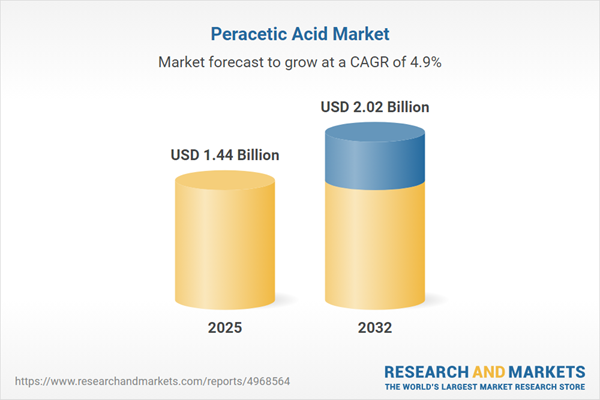Speak directly to the analyst to clarify any post sales queries you may have.
The peracetic acid market is experiencing sustained expansion, driven by rising regulatory focus on sustainability and diverse end-user adoption. This report delivers the actionable insights and precise segmentation data that senior leaders need to evaluate opportunities and risks in the current landscape.
Market Snapshot: Peracetic Acid Market Size and Growth
The Peracetic Acid Market grew from USD 1.38 billion in 2024 to USD 1.44 billion in 2025. It is projected to continue expanding at a CAGR of 4.86%, reaching USD 2.02 billion by 2032. A mounting preference for green chemistry, combined with stricter environmental standards and the demand for efficient microbial control, has firmly established peracetic acid in multiple industrial and commercial roles. This segment is marked by evolving regulatory frameworks, increased market diversity, and heightened innovation in product offerings.
Scope & Segmentation
This report provides a comprehensive analysis across geographies, application areas, and supply chain segments. It covers recent developments, competitive moves, and future outlook.
- Grades: Food Grade, Pharmaceutical Grade, Technical Grade
- Forms: Liquid Concentrate, Ready To Use
- Concentration Levels: High (>15 percent), Medium (5-15 percent), Low (<5 percent)
- Packaging Types: Bottles, Drums, Bulk Tanks
- Applications: Agricultural Sanitization, Food Processing (Beverages, Dairy, Fruits and Vegetables, Meat and Poultry), Healthcare, Pharmaceutical Manufacturing, Pulp and Paper Bleaching, Water Treatment
- Distribution Channels: Direct Sales, Online Sales, Third-Party Distributors
- Geographies: Americas (North America; United States, Canada, Mexico; Latin America: Brazil, Argentina, Chile, Colombia, Peru), Europe, Middle East & Africa (including United Kingdom, Germany, France, Russia, Italy, Spain, Netherlands, Sweden, Poland, Switzerland, UAE, Saudi Arabia, Qatar, Turkey, Israel, South Africa, Nigeria, Egypt, Kenya), Asia-Pacific (China, India, Japan, Australia, South Korea, Indonesia, Thailand, Malaysia, Singapore, Taiwan)
- Leading Companies: Solvay S.A., Evonik Industries AG, Kemira Oyj, Nouryon Chemicals B.V., Arkema S.A., Mitsubishi Gas Chemical Company Inc., Zschimmer & Schwarz GmbH & Co. KG, Dequest LLC, CABB GmbH, National Peroxide Limited
Key Takeaways for Peracetic Acid Market Leaders
- Peracetic acid solutions are benefiting from high demand in food processing and water treatment due to heightened safety and hygiene expectations.
- Technological advancements—such as stabilized blends and modular reactor platforms—are shaping operational efficiency and risk mitigation at scale.
- Regulatory dynamics remain a primary driver, with ongoing evolution in environmental requirements and compliance practices influencing commercial priorities.
- Market participants are diversifying distribution models, leveraging both digital sales and traditional channels to reach an expanding set of end users.
- Sustainability is becoming a source of competitive differentiation, as companies seek to validate environmental credentials and improve supply chain performance.
Tariff Impact and Strategic Responses
Recent import tariffs imposed by the United States on key peracetic acid feedstocks and finished products have increased input costs and prompted a shift towards local production. Market players are responding by optimizing sourcing strategies, forging local supplier partnerships, and refining traceability systems to ensure compliance amid shifting trade policies.
Methodology & Data Sources
This research uses a multi-tiered methodology comprising primary interviews with manufacturers and experts, comprehensive secondary data analysis, and regulatory assessment. Findings reflect cross-validated insights from industry stakeholders, patent filings, and technical literature, supported by monitoring of regulatory trends and supply chain developments.
Why This Report Matters
- Delivers the in-depth segmentation and regional context needed for strategic planning and investment decisions in the peracetic acid market.
- Provides targeted competitive intelligence—including technology trends, sustainability differentiators, and partnership strategies—to inform long-term growth initiatives.
- Supports proactive mitigation of market risks tied to regulatory changes, supply chain fluctuations, and evolving customer requirements.
Conclusion
The peracetic acid market is characterized by innovation, regulatory influence, and sector diversity. Businesses that align technology investment, compliance, and sustainability strategies are best positioned to succeed as industry dynamics evolve.
Additional Product Information:
- Purchase of this report includes 1 year online access with quarterly updates.
- This report can be updated on request. Please contact our Customer Experience team using the Ask a Question widget on our website.
Table of Contents
3. Executive Summary
4. Market Overview
7. Cumulative Impact of Artificial Intelligence 2025
Companies Mentioned
The companies profiled in this Peracetic Acid market report include:- Solvay S.A.
- Evonik Industries AG
- Kemira Oyj
- Nouryon Chemicals B.V.
- Arkema S.A.
- Mitsubishi Gas Chemical Company, Inc.
- Zschimmer & Schwarz GmbH & Co. KG
- Dequest, LLC
- CABB GmbH
- National Peroxide Limited
Table Information
| Report Attribute | Details |
|---|---|
| No. of Pages | 195 |
| Published | October 2025 |
| Forecast Period | 2025 - 2032 |
| Estimated Market Value ( USD | $ 1.44 Billion |
| Forecasted Market Value ( USD | $ 2.02 Billion |
| Compound Annual Growth Rate | 4.8% |
| Regions Covered | Global |
| No. of Companies Mentioned | 11 |









